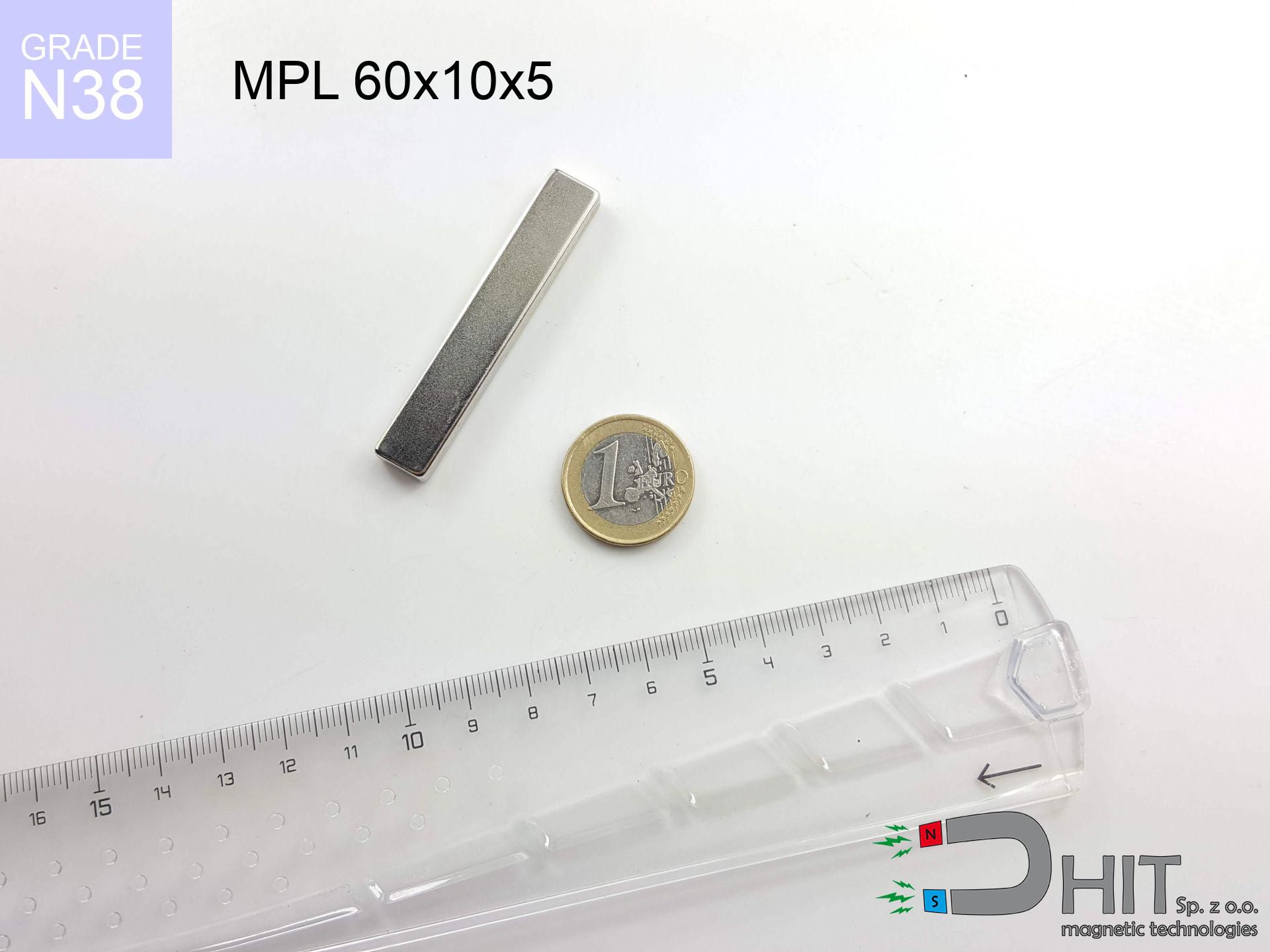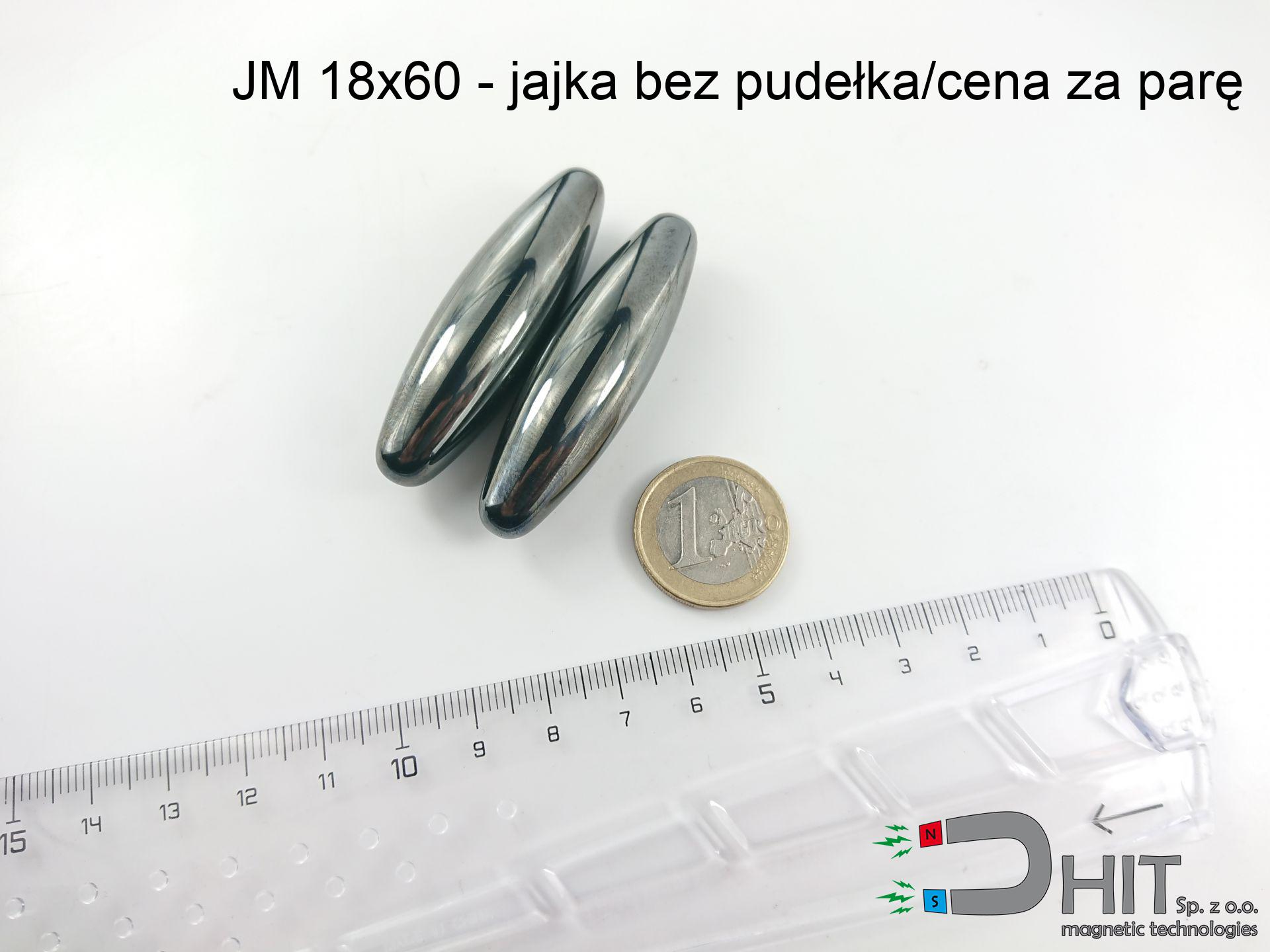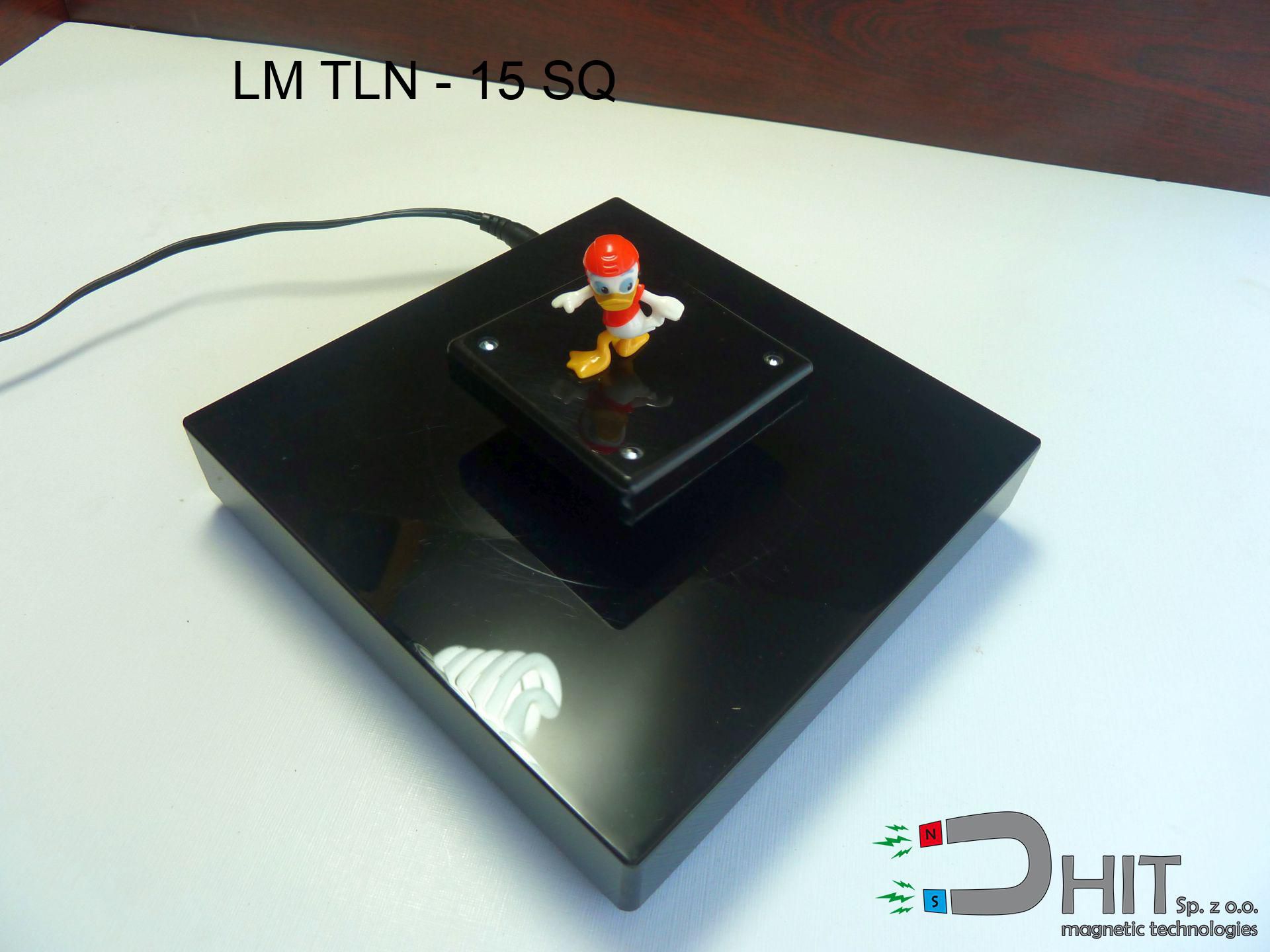MPL 60x10x5 / N38 - lamellar magnet
lamellar magnet
Catalog no 020474
GTIN: 5906301811947
length
60 mm [±0,1 mm]
Width
10 mm [±0,1 mm]
Height
5 mm [±0,1 mm]
Weight
22.5 g
Magnetization Direction
↑ axial
Load capacity
22.32 kg / 218.94 N
Magnetic Induction
315.09 mT
Coating
[NiCuNi] Nickel
19.00 ZŁ with VAT / pcs + price for transport
15.45 ZŁ net + 23% VAT / pcs
bulk discounts:
Need more?Need help making a decision?
Give us a call
+48 22 499 98 98
or contact us by means of
request form
through our site.
Lifting power along with appearance of a neodymium magnet can be checked on our
force calculator.
Order by 14:00 and we’ll ship today!
MPL 60x10x5 / N38 - lamellar magnet
Specification / characteristics MPL 60x10x5 / N38 - lamellar magnet
| properties | values |
|---|---|
| Cat. no. | 020474 |
| GTIN | 5906301811947 |
| Production/Distribution | Dhit sp. z o.o. |
| Country of origin | Poland / China / Germany |
| Customs code | 85059029 |
| length | 60 mm [±0,1 mm] |
| Width | 10 mm [±0,1 mm] |
| Height | 5 mm [±0,1 mm] |
| Weight | 22.5 g |
| Magnetization Direction | ↑ axial |
| Load capacity ~ ? | 22.32 kg / 218.94 N |
| Magnetic Induction ~ ? | 315.09 mT |
| Coating | [NiCuNi] Nickel |
| Manufacturing Tolerance | ±0.1 mm |
Magnetic properties of material N38
| properties | values | units |
|---|---|---|
| remenance Br [Min. - Max.] ? | 12.2-12.6 | kGs |
| remenance Br [Min. - Max.] ? | 1220-1260 | T |
| coercivity bHc ? | 10.8-11.5 | kOe |
| coercivity bHc ? | 860-915 | kA/m |
| actual internal force iHc | ≥ 12 | kOe |
| actual internal force iHc | ≥ 955 | kA/m |
| energy density [Min. - Max.] ? | 36-38 | BH max MGOe |
| energy density [Min. - Max.] ? | 287-303 | BH max KJ/m |
| max. temperature ? | ≤ 80 | °C |
Physical properties of sintered neodymium magnets Nd2Fe14B at 20°C
| properties | values | units |
|---|---|---|
| Vickers hardness | ≥550 | Hv |
| Density | ≥7.4 | g/cm3 |
| Curie Temperature TC | 312 - 380 | °C |
| Curie Temperature TF | 593 - 716 | °F |
| Specific resistance | 150 | μΩ⋅Cm |
| Bending strength | 250 | Mpa |
| Compressive strength | 1000~1100 | Mpa |
| Thermal expansion parallel (∥) to orientation (M) | (3-4) x 106 | °C-1 |
| Thermal expansion perpendicular (⊥) to orientation (M) | -(1-3) x 10-6 | °C-1 |
| Young's modulus | 1.7 x 104 | kg/mm² |
Technical analysis of the product - technical parameters
Presented information are the result of a mathematical analysis. Results rely on algorithms for the class NdFeB. Operational conditions might slightly differ. Please consider these calculations as a preliminary roadmap for designers.
MPL 60x10x5 / N38
| Distance (mm) | Induction (Gauss) / mT | Pull Force (kg) | Risk Status |
|---|---|---|---|
| 0 mm |
4252 Gs
425.2 mT
|
22.32 kg / 22320.0 g
219.0 N
|
crushing |
| 1 mm |
3687 Gs
368.7 mT
|
16.79 kg / 16787.1 g
164.7 N
|
crushing |
| 2 mm |
3107 Gs
310.7 mT
|
11.92 kg / 11920.0 g
116.9 N
|
crushing |
| 5 mm |
1317 Gs
131.7 mT
|
2.14 kg / 2142.5 g
21.0 N
|
medium risk |
| 10 mm |
598 Gs
59.8 mT
|
0.44 kg / 440.9 g
4.3 N
|
weak grip |
| 15 mm |
330 Gs
33.0 mT
|
0.13 kg / 134.3 g
1.3 N
|
weak grip |
| 20 mm |
205 Gs
20.5 mT
|
0.05 kg / 51.9 g
0.5 N
|
weak grip |
| 30 mm |
96 Gs
9.6 mT
|
0.01 kg / 11.4 g
0.1 N
|
weak grip |
| 50 mm |
31 Gs
3.1 mT
|
0.00 kg / 1.2 g
0.0 N
|
weak grip |
MPL 60x10x5 / N38
| Surface type | Friction coefficient / % Mocy | Max load (kg) |
|---|---|---|
| Raw steel |
µ = 0.3
30% Nominalnej Siły
|
6.70 kg / 6696.0 g
65.7 N
|
| Painted steel (standard) |
µ = 0.2
20% Nominalnej Siły
|
4.46 kg / 4464.0 g
43.8 N
|
| Oily/slippery steel |
µ = 0.1
10% Nominalnej Siły
|
2.23 kg / 2232.0 g
21.9 N
|
| Magnet with anti-slip rubber |
µ = 0.5
50% Nominalnej Siły
|
11.16 kg / 11160.0 g
109.5 N
|
MPL 60x10x5 / N38
| Steel thickness (mm) | % power | Real pull force (kg) |
|---|---|---|
| 0.5 mm |
|
1.12 kg / 1116.0 g
10.9 N
|
| 1 mm |
|
2.79 kg / 2790.0 g
27.4 N
|
| 2 mm |
|
5.58 kg / 5580.0 g
54.7 N
|
| 5 mm |
|
13.95 kg / 13950.0 g
136.8 N
|
| 10 mm |
|
22.32 kg / 22320.0 g
219.0 N
|
MPL 60x10x5 / N38
| Ambient temp. (°C) | Power loss | Remaining pull | Status |
|---|---|---|---|
| 20 °C | 0.0% |
22.32 kg / 22320.0 g
219.0 N
|
OK |
| 40 °C | -2.2% |
21.83 kg / 21829.0 g
214.1 N
|
OK |
| 60 °C | -4.4% |
21.34 kg / 21337.9 g
209.3 N
|
OK |
| 80 °C | -6.6% |
20.85 kg / 20846.9 g
204.5 N
|
|
| 100 °C | -28.8% |
15.89 kg / 15891.8 g
155.9 N
|
MPL 60x10x5 / N38
| Gap (mm) | Attraction (kg) (N-S) | Repulsion (kg) (N-N) |
|---|---|---|
| 0 mm |
33.48 kg / 33480.0 g
328.4 N
|
N/A |
| 2 mm |
17.88 kg / 17880.0 g
175.4 N
|
16.69 kg / 16688.0 g
163.7 N
|
| 5 mm |
3.21 kg / 3210.0 g
31.5 N
|
3.00 kg / 2996.0 g
29.4 N
|
| 10 mm |
0.66 kg / 660.0 g
6.5 N
|
0.62 kg / 616.0 g
6.0 N
|
| 20 mm |
0.08 kg / 75.0 g
0.7 N
|
0.07 kg / 70.0 g
0.7 N
|
| 50 mm |
0.00 kg / 0.0 g
0.0 N
|
0.00 kg / 0.0 g
0.0 N
|
MPL 60x10x5 / N38
| Object / Device | Limit (Gauss) / mT | Safe distance |
|---|---|---|
| Pacemaker | 5 Gs (0.5 mT) | 10.5 cm |
| Hearing aid | 10 Gs (1.0 mT) | 8.0 cm |
| Mechanical watch | 20 Gs (2.0 mT) | 6.0 cm |
| Mobile device | 40 Gs (4.0 mT) | 4.5 cm |
| Remote | 50 Gs (5.0 mT) | 4.5 cm |
| Payment card | 400 Gs (40.0 mT) | 1.5 cm |
| HDD hard drive | 600 Gs (60.0 mT) | 1.0 cm |
MPL 60x10x5 / N38
| Start from (mm) | Speed (km/h) | Energy (J) | Predicted outcome |
|---|---|---|---|
| 10 mm |
32.15 km/h
(8.93 m/s)
|
0.90 J | |
| 30 mm |
55.03 km/h
(15.29 m/s)
|
2.63 J | |
| 50 mm |
71.03 km/h
(19.73 m/s)
|
4.38 J | |
| 100 mm |
100.45 km/h
(27.90 m/s)
|
8.76 J |
MPL 60x10x5 / N38
| Technical parameter | Value / Description |
|---|---|
| Coating type | [NiCuNi] Nickel |
| Layer structure | Nickel - Copper - Nickel |
| Layer thickness | 10-20 µm |
| Salt spray test (SST) ? | 24 h |
| Recommended environment | Indoors only (dry) |
MPL 60x10x5 / N38
| Environment | Effective steel pull | Effect |
|---|---|---|
| Air (land) | 22.32 kg | Standard |
| Water (riverbed) |
25.56 kg
(+3.24 kg Buoyancy gain)
|
+14.5% |
Other offers
Pros and cons of neodymium magnets.
Besides their tremendous pulling force, neodymium magnets offer the following advantages:
- They do not lose magnetism, even during around 10 years – the reduction in lifting capacity is only ~1% (based on measurements),
- Magnets perfectly resist against loss of magnetization caused by ambient magnetic noise,
- By using a lustrous coating of silver, the element has an professional look,
- Neodymium magnets create maximum magnetic induction on a small area, which allows for strong attraction,
- Through (appropriate) combination of ingredients, they can achieve high thermal strength, enabling action at temperatures approaching 230°C and above...
- Thanks to modularity in shaping and the capacity to customize to individual projects,
- Wide application in innovative solutions – they are commonly used in mass storage devices, electric drive systems, advanced medical instruments, also multitasking production systems.
- Relatively small size with high pulling force – neodymium magnets offer high power in tiny dimensions, which makes them useful in small systems
Disadvantages of neodymium magnets:
- To avoid cracks under impact, we recommend using special steel holders. Such a solution protects the magnet and simultaneously increases its durability.
- Neodymium magnets demagnetize when exposed to high temperatures. After reaching 80°C, many of them experience permanent drop of strength (a factor is the shape and dimensions of the magnet). We offer magnets specially adapted to work at temperatures up to 230°C marked [AH], which are extremely resistant to heat
- Magnets exposed to a humid environment can rust. Therefore while using outdoors, we recommend using water-impermeable magnets made of rubber, plastic or other material resistant to moisture
- Due to limitations in realizing threads and complex shapes in magnets, we propose using cover - magnetic mechanism.
- Possible danger related to microscopic parts of magnets are risky, if swallowed, which is particularly important in the context of child safety. Additionally, tiny parts of these devices can complicate diagnosis medical after entering the body.
- Higher cost of purchase is a significant factor to consider compared to ceramic magnets, especially in budget applications
Detachment force of the magnet in optimal conditions – what contributes to it?
The force parameter is a measurement result executed under specific, ideal conditions:
- with the application of a yoke made of low-carbon steel, guaranteeing full magnetic saturation
- possessing a thickness of minimum 10 mm to ensure full flux closure
- characterized by lack of roughness
- without the slightest clearance between the magnet and steel
- under vertical force direction (90-degree angle)
- in temp. approx. 20°C
Practical aspects of lifting capacity – factors
Real force impacted by working environment parameters, including (from priority):
- Air gap (betwixt the magnet and the metal), because even a microscopic clearance (e.g. 0.5 mm) leads to a reduction in force by up to 50% (this also applies to paint, corrosion or dirt).
- Pull-off angle – note that the magnet has greatest strength perpendicularly. Under sliding down, the capacity drops significantly, often to levels of 20-30% of the nominal value.
- Metal thickness – thin material does not allow full use of the magnet. Magnetic flux passes through the material instead of generating force.
- Material type – the best choice is pure iron steel. Hardened steels may have worse magnetic properties.
- Plate texture – ground elements guarantee perfect abutment, which increases force. Uneven metal reduce efficiency.
- Thermal environment – heating the magnet causes a temporary drop of induction. It is worth remembering the thermal limit for a given model.
* Lifting capacity testing was performed on plates with a smooth surface of suitable thickness, under a perpendicular pulling force, in contrast under attempts to slide the magnet the holding force is lower. In addition, even a small distance {between} the magnet’s surface and the plate decreases the holding force.
Warnings
Eye protection
Despite metallic appearance, neodymium is delicate and cannot withstand shocks. Do not hit, as the magnet may crumble into hazardous fragments.
Do not underestimate power
Use magnets consciously. Their huge power can surprise even professionals. Stay alert and do not underestimate their force.
Safe distance
Very strong magnetic fields can erase data on payment cards, hard drives, and other magnetic media. Maintain a gap of min. 10 cm.
Skin irritation risks
Medical facts indicate that the nickel plating (the usual finish) is a strong allergen. If your skin reacts to metals, avoid direct skin contact and opt for encased magnets.
Mechanical processing
Fire hazard: Rare earth powder is explosive. Avoid machining magnets in home conditions as this may cause fire.
Swallowing risk
Absolutely store magnets away from children. Choking hazard is high, and the consequences of magnets clamping inside the body are very dangerous.
Medical implants
Medical warning: Strong magnets can turn off heart devices and defibrillators. Do not approach if you have medical devices.
Magnetic interference
A strong magnetic field interferes with the functioning of compasses in smartphones and GPS navigation. Keep magnets close to a device to prevent breaking the sensors.
Crushing force
Protect your hands. Two powerful magnets will snap together immediately with a force of massive weight, crushing everything in their path. Exercise extreme caution!
Do not overheat magnets
Keep cool. NdFeB magnets are susceptible to temperature. If you require operation above 80°C, ask us about special high-temperature series (H, SH, UH).
Attention!
Need more info? Read our article: Are neodymium magnets dangerous?




![AM ucho małe [M8] - magnetic accessories AM ucho małe [M8] - magnetic accessories](https://cdn3.dhit.pl/graphics/products/am-ucho-małe-m8-zud.jpg)



